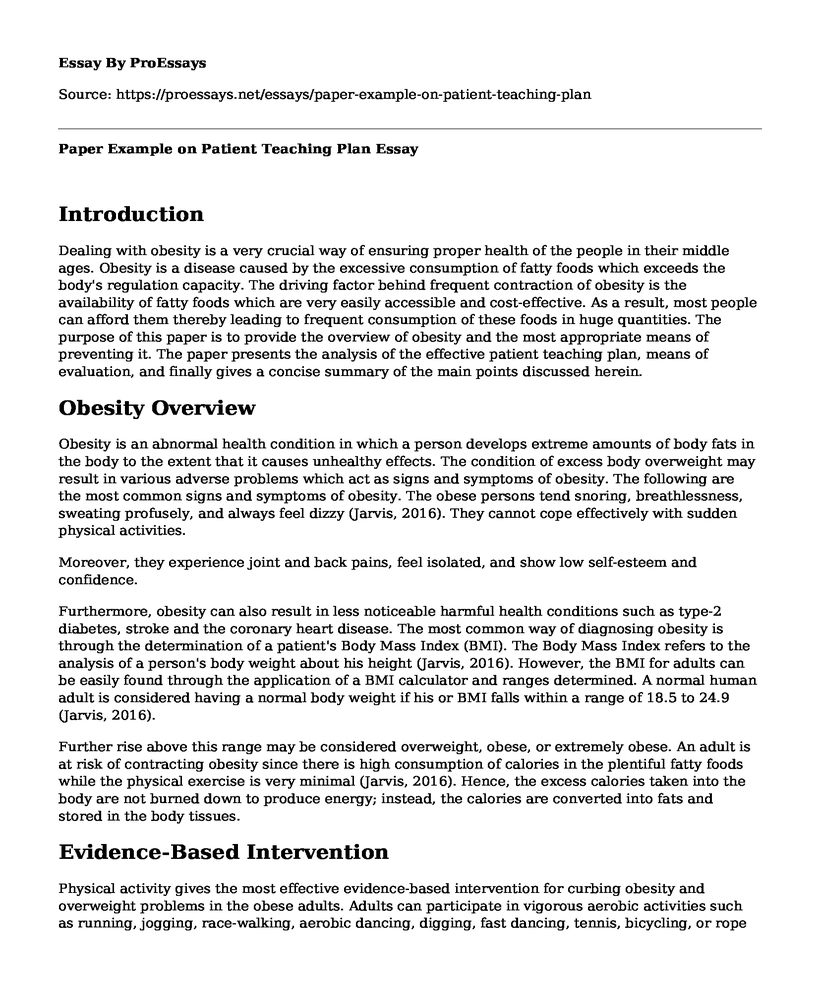Introduction
Dealing with obesity is a very crucial way of ensuring proper health of the people in their middle ages. Obesity is a disease caused by the excessive consumption of fatty foods which exceeds the body's regulation capacity. The driving factor behind frequent contraction of obesity is the availability of fatty foods which are very easily accessible and cost-effective. As a result, most people can afford them thereby leading to frequent consumption of these foods in huge quantities. The purpose of this paper is to provide the overview of obesity and the most appropriate means of preventing it. The paper presents the analysis of the effective patient teaching plan, means of evaluation, and finally gives a concise summary of the main points discussed herein.
Obesity Overview
Obesity is an abnormal health condition in which a person develops extreme amounts of body fats in the body to the extent that it causes unhealthy effects. The condition of excess body overweight may result in various adverse problems which act as signs and symptoms of obesity. The following are the most common signs and symptoms of obesity. The obese persons tend snoring, breathlessness, sweating profusely, and always feel dizzy (Jarvis, 2016). They cannot cope effectively with sudden physical activities.
Moreover, they experience joint and back pains, feel isolated, and show low self-esteem and confidence.
Furthermore, obesity can also result in less noticeable harmful health conditions such as type-2 diabetes, stroke and the coronary heart disease. The most common way of diagnosing obesity is through the determination of a patient's Body Mass Index (BMI). The Body Mass Index refers to the analysis of a person's body weight about his height (Jarvis, 2016). However, the BMI for adults can be easily found through the application of a BMI calculator and ranges determined. A normal human adult is considered having a normal body weight if his or BMI falls within a range of 18.5 to 24.9 (Jarvis, 2016).
Further rise above this range may be considered overweight, obese, or extremely obese. An adult is at risk of contracting obesity since there is high consumption of calories in the plentiful fatty foods while the physical exercise is very minimal (Jarvis, 2016). Hence, the excess calories taken into the body are not burned down to produce energy; instead, the calories are converted into fats and stored in the body tissues.
Evidence-Based Intervention
Physical activity gives the most effective evidence-based intervention for curbing obesity and overweight problems in the obese adults. Adults can participate in vigorous aerobic activities such as running, jogging, race-walking, aerobic dancing, digging, fast dancing, tennis, bicycling, or rope jumping. The appropriate administration of such physical exercise activities helps in reducing the abdominal fat content, thereby, enhancing the steady and controlled weight loss (Jarvis, 2016). Additionally, the physical exercise also improves cardiorespiratory fitness which discourages the contraction of heart disease.
Teaching Plan
The adult participants will be taken through moderate physical activities. They will be required to choose among the various physical activities they would like to undertake and then guided through it on a daily basis. The physical activity options will include running, jogging, race-walking, aerobic dancing, digging, fast dancing, tennis, bicycling, or rope jumping. The adult person will then be guided through the chosen activity for 30 to 45 minutes every day for 3 to 5 days each week. However, they shall be encouraged to extend these activities for more extended periods. Guides to effective weight loss will be provided to each participant. However, they will also be encouraged to do more studies on the internet and the community gymnastics facility to enrich their knowledge and skills for more efficient and effective weight loss (Jarvis, 2016).
Evaluation
The participants will undergo the BMI evaluation every week to affirm any changes to their status. For positive results, the participants will be encouraged to proceed even the more. However, for those whose results will need improvements, more intense measures will be applied such as giving them more time during exercises, or even integrating the dietary therapy in addition to the physical exercise (Jarvis, 2016).
Summary
Obesity is a hazardous yet controllable health condition which affects both children, adolescents, as well as the adults. It is associated with several signs and symptoms such as dizziness, too much sweating, breathlessness, snoring, and loss of confidence and self-esteem. The condition can be diagnosed through the Body Mass Index technique. There are various measures for controlling obesity including the administration of physical exercise and dietary therapy (Jarvis, 2016). After the successful accomplishment of this patient teaching plan, there will be a great decrease in the obesity cases in the community. As a result, cases of the associated disorders such as heart disease, type-2 diabetes, and stroke will be dramatically minimized.
References
Jarvis, C. (2016). Physical examination & health assessment (7th ed.). St. Louis, MO: Saunders/Elsevier.
Cite this page
Paper Example on Patient Teaching Plan. (2022, Jul 20). Retrieved from https://proessays.net/essays/paper-example-on-patient-teaching-plan
If you are the original author of this essay and no longer wish to have it published on the ProEssays website, please click below to request its removal:
- Opioid Problem in the United States Essay
- Article Analysis Essay on Nurse-Driven Mobility Protocol
- Essay Sample on Vaccine Doses
- Reflective Essay Sample on A Healthcare Assistant
- Paper Example on Living with Diabetes Type 1: How to Manage & Live Healthily
- Nutrition Care Plan for COPD - Essay Sample
- Essay Example on Modern Medical Technology: Improving Health Outcomes







